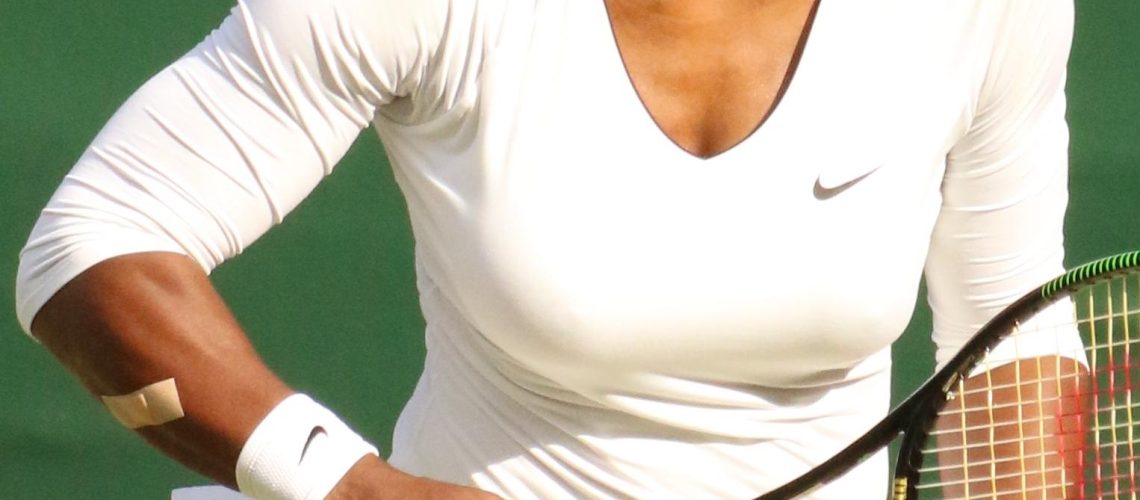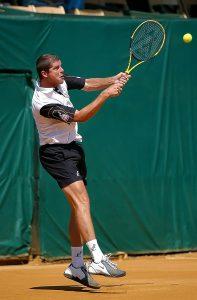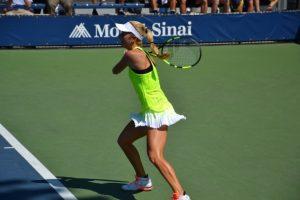We may earn money or products from the companies mentioned in this post.
Brief History of Tennis

Tennis, a sport that originated in 19th century England, has evolved into a beloved global phenomenon Initially known as “lawn tennis,” it was played on grass courts by the upper-class gentry Over time, the sport gained popularity and spread across different continents, with various modifications to its rules and playing surfaces
Importance of Serving in Tennis

Serving is a fundamental aspect of tennis and holds immense importance in determining the outcome of matches The serve acts as the starting point for every rally, giving players an opportunity to set the tone and gain an advantage right from the beginning A well-executed serve can create opportunities for powerful groundstrokes or strategic net play while a weak or inconsistent serve can put a player at a disadvantage
Purpose of the Article – An Exhaustive Guide on Chances to Serve in Tennis

The purpose of this article is to provide tennis enthusiasts with an exhaustive guide on chances to serve in tennis We will delve into various aspects related to serving, including different types of serves, techniques, strategies, and tips for improving your serving game Whether you are a beginner looking to learn the basics or an advanced player aiming to refine your skills, this comprehensive guide aims to equip you with valuable insights and practical advice
The Basics of Serving in Tennis

When it comes to serving in tennis, there are a few key elements that players must keep in mind Firstly, the correct stance, grip, and motion are crucial for a successful serve Players need to find a comfortable stance that allows them to generate power and balance The grip on the racket should be firm but not too tight, allowing for flexibility and control during the swing Lastly, the motion of the serve should be smooth and fluid, combining both power and accuracy
In addition to understanding the fundamentals of serving technique, players should also familiarize themselves with different types of serves There are three main types: flat, slice, and kick serves Each serve has its own unique characteristics and can be used strategically during a match The flat serve is known for its speed and minimal spin, while the slice serve involves sidespin that can cause difficulties for opponents Lastly, the kick serve utilizes topspin to create a high bounce that can catch opponents off guard
Scoring System in Tennis Matches

Tennis matches have their own unique scoring system that may seem confusing at first glance However, once you understand how it works, it becomes much clearer The point system consists of four stages – love (zero points), 15 points, 30 points, and 40 points To win a game, players must earn four points while maintaining a lead of at least two points over their opponent
To win an entire set or match in tennis requires winning multiple games through consistent play In each set played (except for tiebreakers), players need to win six games with a lead of at least two games over their opponent to secure victory in that particular set And finally, winning the match involves winning either two out of three sets in regular matches or three out of five sets in Grand Slam matches
Faults and Double Faults During a Service Game

Faults are an unfortunate but common occurrence during a service game A fault is when a player fails to execute a legal serve on their first attempt There are several ways this can happen Firstly, a foot fault occurs when the server’s foot touches or crosses over the baseline before making contact with the ball Secondly, if the ball does not land within the service box designated on the opposite side of the net, it counts as a fault Lastly, hitting the net with the serve before it lands within the service box also results in a fault
Double faults are another aspect of serving that players want to avoid A double fault happens when both the first and second serves are unsuccessful, resulting in two faults in a row It can be frustrating for players as it means losing their chance to win that particular point and being forced to try again with their next service attempt
How many chances do you get to serve in tennis?

In the game of tennis, serving is a crucial aspect that can heavily influence the outcome of a match The number of chances a player gets to serve varies depending on different factors
Number of serves per game
In tennis, players typically have two opportunities to serve for each point – the first serve and the second serve This gives them a chance to put their skills to the test and try to gain an advantage over their opponent
However, it’s important to note that there are potential scenarios that may lead to either a win or loss of points after serving For example, if a player fails to get their first serve in play, they will have another attempt with their second serve But if they also miss their second serve, it results in a double fault, awarding the point to their opponent
Variation by game format
The number of chances to serve can also vary depending on the format of the game being played
-
Singles matches:
In singles matches, players compete against each other one-on-one The number of games per set and sets per match can differ based on tournament rules or level of play - a) Number of games per set: Typically, singles matches consist of six games per set
- b) Number of sets per match: Matches are generally played as best-of-three sets or best-of-five sets at higher levels
-
Doubles matches:
In doubles matches, two teams consisting of two players each face off against each other - a) Role switching between partners during serving games: In doubles matches, the serving team alternates between partners after each game This adds an extra layer of strategy and coordination to the game
- b) Ad court vs Deuce court serves: The serving team can choose which player serves from either the ad court or deuce court, providing them with flexibility in their serving strategy
Understanding how many chances one gets to serve in tennis is essential for players to strategize their gameplay effectively It’s not just about hitting the ball over the net; it’s about making every opportunity count and seizing control of the match
Strategies for Maximizing Your Chances While Serving

When it comes to serving in tennis, having a few tricks up your sleeve can make all the difference By practicing different types of serves, improving consistency, and adapting to your opponent’s strengths and weaknesses, you can significantly increase your chances of winning points Let’s dive into some strategies that will help you take your serving game to the next level
Practice Different Types of Serves
1 Ace or unreturnable serves leading to direct winning points without rallies:
Serving an ace is like hitting a bullseye on the court – it’s an instant point winner for you By practicing powerful and accurate serves that are hard for your opponent to return, you’ll be able to rack up those easy points and put pressure on their return game
2 Placement and spin variations for increasing unpredictability:
Variety is key when it comes to serving in tennis Experiment with different placements and spin variations to keep your opponent guessing Mix up your serves by aiming for different corners of the service box or adding topspin or slice to add extra complexity
Improving Serve Consistency
1 Techniques for reducing faults and double faults:
Faults and double faults can be frustrating and costly in a match To improve serve consistency, focus on refining your technique and developing a smooth rhythm Pay attention to your toss, footwork, and timing while maintaining good posture throughout the motion
2Tips on how to practice and develop a reliable second serve:
Your second serve is just as important as your first, so dedicate time to practicing it separately Work on getting a consistent ball toss, generating enough spin or kick to keep your opponent off balance, and finding the right balance between power and control Developing confidence in your second serve will give you a safety net when your first serve isn’t firing on all cylinders
Adapting to Your Opponent’s Strengths and Weaknesses
1Analyzing the opponent’s return of serve tendencies:
Paying attention to how your opponent returns serves can provide valuable insights for adjusting your strategy Observe their positioning, footwork, and shot selection when returning different types of serves This analysis will help you identify patterns and exploit any weaknesses in their return game
2Exploiting weaknesses in their return game:
Once you’ve identified your opponent’s weaknesses, it’s time to capitalize on them Target their weaker side with well-placed serves or use specific spins that trouble them the most By strategically exploiting these weaknesses, you can gain an advantage and put pressure on their entire service game
In conclusion,
By implementing these strategies into your serving arsenal, you’ll be able to maximize your chances of winning points and gaining an edge over your opponents Remember to practice consistently, adapt to different situations, and stay focused during matches With time and dedication, you’ll see significant improvements in your serving game that will translate into more victories on the tennis court
Conclusion

In conclusion, this article has highlighted the importance of mastering serves in tennis We have discussed various techniques and strategies to enhance serving skills, including proper stance, grip, and swing mechanics Additionally, we have emphasized the significance of a strong serve for overall success in the game
Summary of Key Points Discussed
Throughout this article, we have explored the following key points:
- The serve is a crucial aspect of tennis that can greatly influence match outcomes
- Having a varied repertoire of serves allows players to keep opponents guessing and maintain control over rallies
- Proper technique and mechanics are essential for maximizing power and accuracy in serves
- Mental preparation and focus play a vital role in executing successful serves under pressure
The Importance of Mastering Serves for Overall Success in Tennis
Mastering serves is essential for achieving overall success in tennis A powerful and accurate serve can help players gain an advantage right from the start of each point It puts pressure on opponents by forcing them to react quickly and often results in weak returns that can be easily capitalized upon
A well-executed serve also allows players to dictate the pace and direction of the game By consistently landing their serves within target areas or utilizing different spin variations, players can control the flow of play and set themselves up for offensive opportunities
Furthermore, a strong serve can boost confidence levels on court When players feel confident about their serving abilities, they approach each point with a positive mindset and become more assertive during rallies This mental edge can make a significant difference in matches where every point matters
Encouragement to Practice and Improve Serving Skills
If you aspire to become a formidable tennis player, dedicating time and effort to practice serving is crucial Regular training sessions focused on refining technique, developing power, and improving accuracy will help you master this essential aspect of the game
Consider working with a coach who can provide guidance and offer personalized drills to enhance your serving skills Additionally, watching professional players’ serves and analyzing their techniques can provide valuable insights that can be incorporated into your own game
Remember, Rome wasn’t built in a day, and neither will your serve be perfected overnight Embrace the process of improvement, stay persistent, and never shy away from challenges With consistent practice and determination, you can elevate your serving proficiency and take your tennis game to new heights
Useful Links

How many serves is a player allowed per game in tennis?
Serve (tennis) – Wikipedia
Serving
Holding Serve: Sole Recipe for Success? | by Aadit Sheth
Second Chances, Second Serve
Basic Tennis Rules
The Odds of Successfully Serving Out the Set
Understanding the Importance of First Serve in Tennis …
How to Serve a Tennis Ball (with Pictures)
Solved A player serving in tennis has two chances to get a
FLOOR TENNIS RULES
Why The Jump Serve Is Illegal In Tennis
What is a Fault in Tennis? Definition, Rules, Tips & Stats
TENNIS RULES
Break Point In Tennis
Ping Pong Singles Rules
Guide to Tennis Serves: 4 Types of Tennis Serves – 2023
Tennis strategy: Knowing the percentages improves your …
Serve with Confidence (Get the best …






